Apple iPad mini with Retina Display: Reviewed
by Anand Lal Shimpi on November 16, 2013 8:00 AM ESTThe SoC
The iPad mini with Retina Display rounds out the three platforms that use Apple’s A7 SoC. Although both the iPad Air and iPhone 5S use the A7, the mini’s implementation is closer in nature to the iPhone. The iPad mini’s SoC has always used the same package-on-package (PoP) assembly as the iPhone, with DRAM stacked on top of the SoC itself (1GB in this case). The benefit is obviously a reduction in board area, the downsides have to do with cost and thermals. That’s the first similarity between the mini’s A7 and the iPhone’s A7.
The second is one of frequencies. While the iPad Air’s A7 runs its two Cyclone CPU cores at up to 1.4GHz, the SoC in the iPad mini and the iPhone 5S runs at up to 1.3GHz. That might sound like a minor difference, but it’s far more pronounced when you look at what happens to frequency when you’re running heavy workloads.
Once again I turn to a fairly heavy CPU workload to plot performance over time. This is a multithreaded workload, slightly modified from what we used in the iPad Air review, designed to make the CPU cores consume max power. The scale is linear and the workload is the same across all devices, so what you’re effectively looking at is a graph of thermally bound CPU performance over time across all three A7 implementations:
Being the largest device (and the only device with a metal heat spreader and no DRAM stacked on top), the iPad Air obviously maintains the highest frequencies for the duration of the test. The iPhone 5S, with a significant reduction in internal volume (and a PoP SoC) reduces its CPU frequencies early on in order to keep skin temperature down and properly manage thermals. The iPad mini with Retina Display falls between the two, with its performance curve more closely following that of the iPhone 5S.
Although the mini has a similar max operating frequency to the iPhone 5S, it is a faster device thanks to it being less thermally constrained. Similarly, the iPad Air can be much faster than its clock speed would otherwise imply. If you’re wondering why Apple has been so focused on building its own SoCs and CPU architectures, this is the reason why. There’s a fixed amount of power you can dissipate in the form of heat in these mobile devices while still maintaining a good user experience. Performance per watt is the gating metric for success in mobile, and shipping high IPC/low frequency dual-core SoCs at 32/28nm is the best optimization available to a company like Apple today.
As you’d expect, our browser based CPU tests show the mini’s A7 performing in between the iPhone 5S and iPad Air. None of these tests are anywhere near as stressful as our thermal test from above, so we don’t see exaggerated differences in performance between the platforms. For most, I suspect you won’t notice a huge performance difference between the mini and Air. Those who are heavier users (e.g. audio mixing, 3D gaming, etc…), there will be a performance difference between the two iPads.
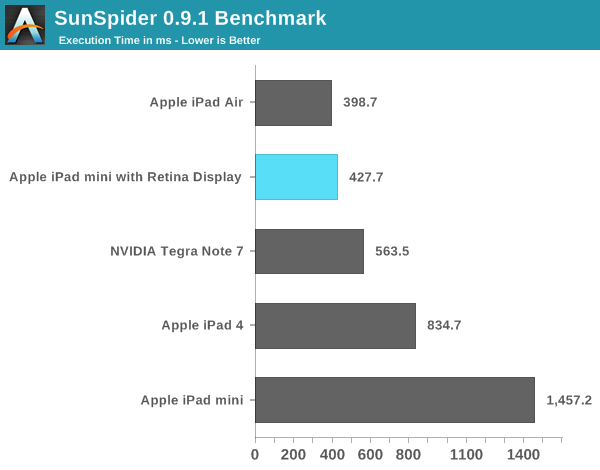

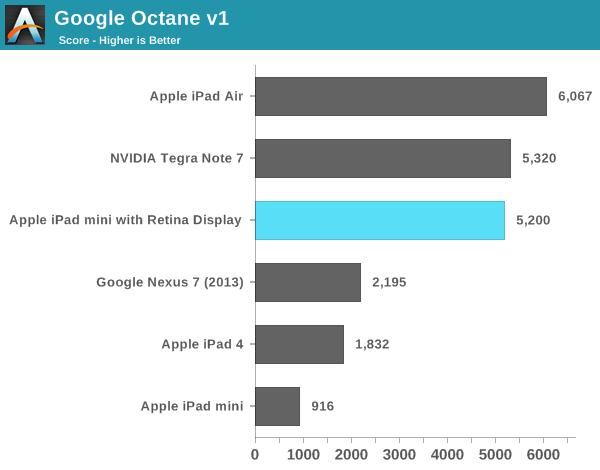
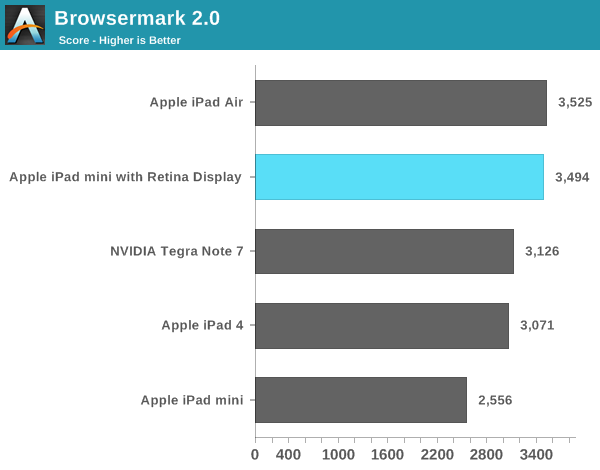
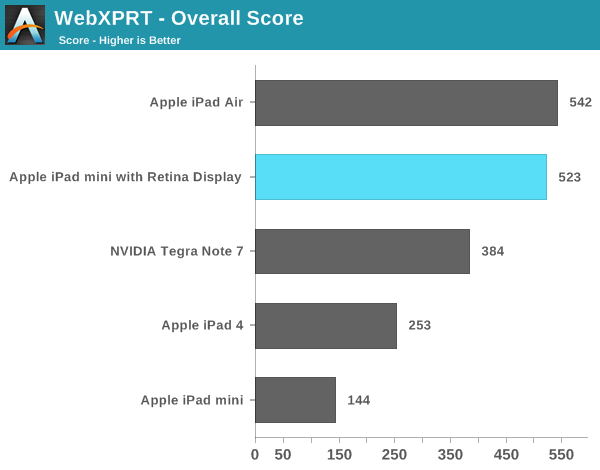
Compared to the first generation iPad mini, the new model is in a completely different performance league. Keep in mind the first mini used Apple’s A5 SoC based on an ARM Cortex A9. That’s the same single threaded performance as what’s in an iPhone 4S, and under iOS 7 it’s clearly running into some performance limits. The new mini with Retina Display however is a completely different animal. It’s fast.
Even comparing to the 4th generation iPad, the new mini is noticeably quicker.
Memory Bandwidth
Looking at the iPad mini’s memory bandwidth curve, we see it tracks very closely with that of the iPhone 5S. This is a slightly modified version of our previous bandwidth test, and you can see peak usable memory bandwidth (from the CPU’s perspective) of around 10GB/s. The ~12GB/s area right before you get out to main memory is bandwidth to the A7’s 4MB system-wide cache that sits after the shared L2 and the memory controller. This cache appears to service CPU, GPU and ISP requests at least.
GPU Performance
I believe the A7’s PowerVR G6430 GPU runs at around 450MHz. This frequency appears unchanged across all three A7 implementations. Once again, the big difference is how much thermal headroom exists in the platform which has an impact on overall performance.
Kishonti’s low level GPU performance tests back up my assertion that GPU frequency is fixed across all A7s. The iPad mini with Retina Display delivers equal performance to the iPad Air. The bigger news here is that nearly all of the GPU bound 3D tests seems to peg the mini and Air as equals. These are some pretty intense tests, but it looks like on the GPU side there’s no significant throttling when running at full tilt.
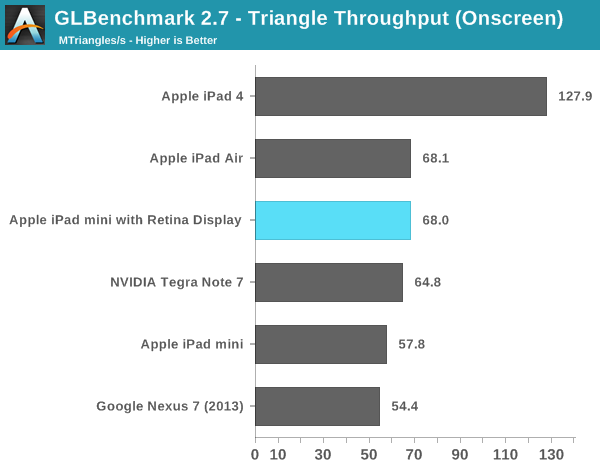

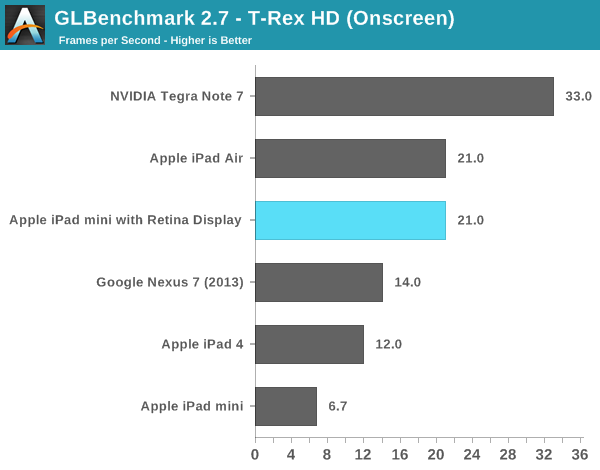

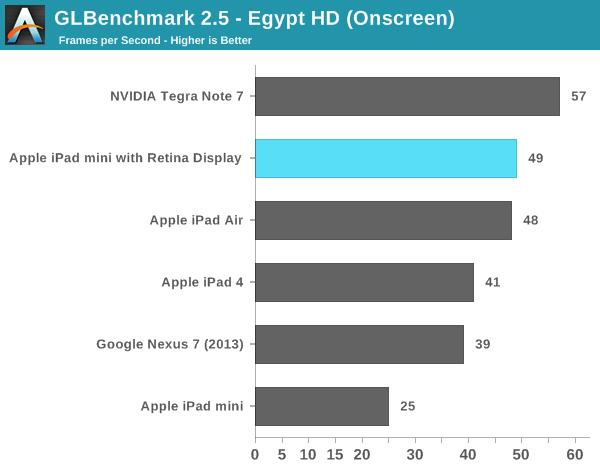
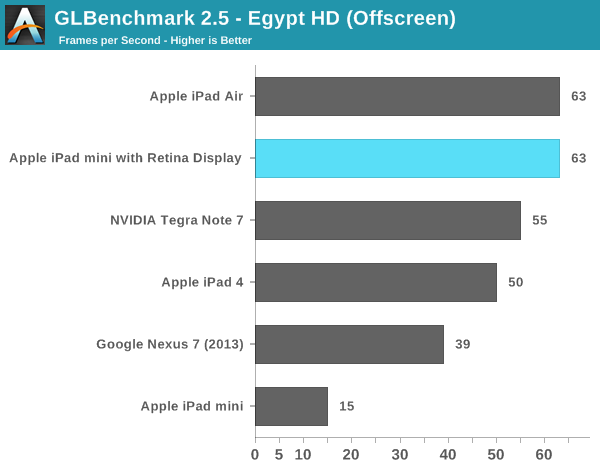
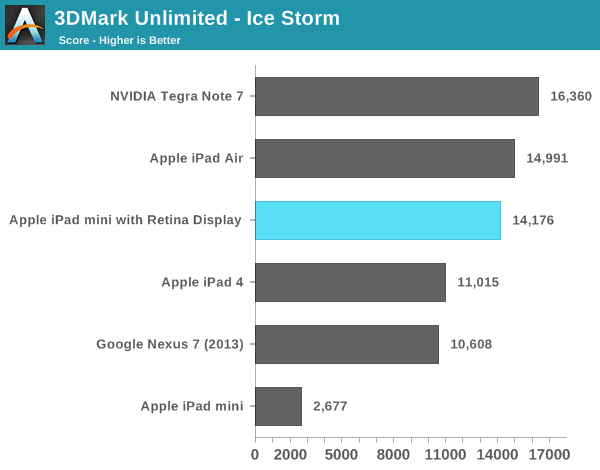
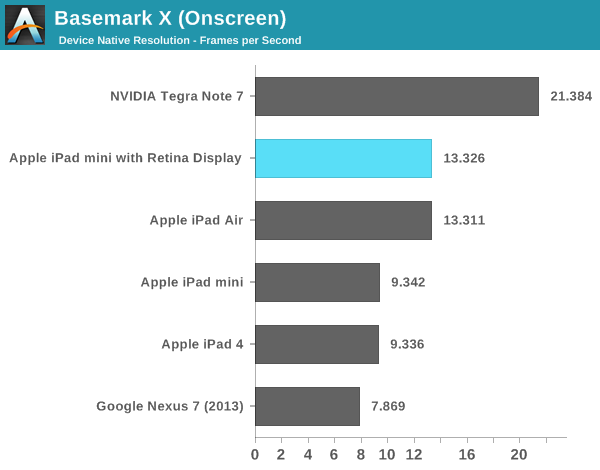
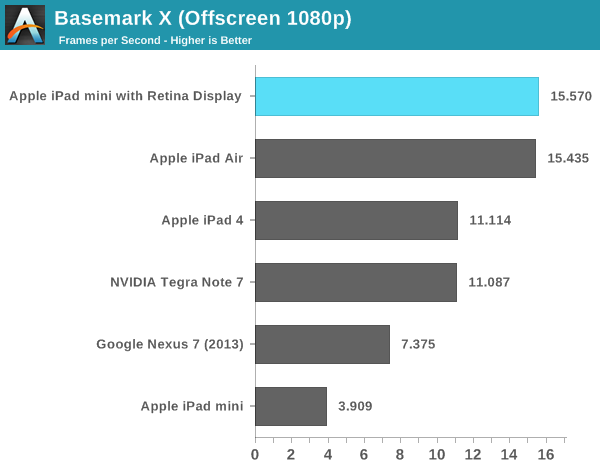
As I mentioned in our iPad Air review, despite having less peak theoretical memory bandwidth than the A5X/A6X, the A7 in the iPad mini never seems to regress in performance compared to even the iPad 4. Across the board the mini appears to be faster, more responsive and have more performance on tap than any prior iPad (big or small). The comparison to the original iPad mini is of course night and day. Even looking at lighter tests like the old GLBench Egypt HD benchmark, the iPad mini with Retina Display manages to be nearly twice as fast as the original mini - all while rendering 4x the number of pixels.


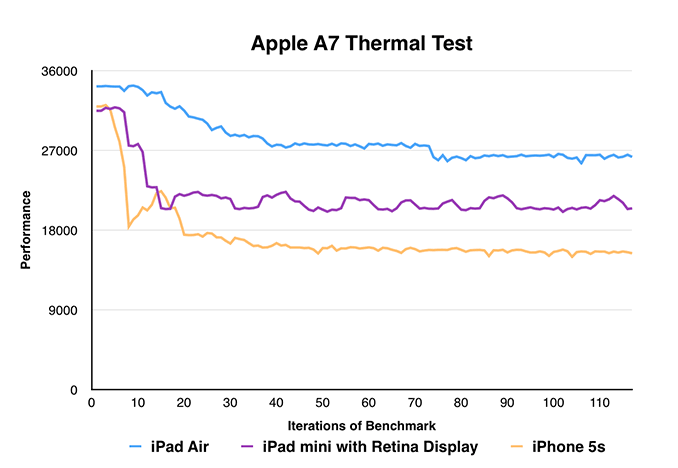
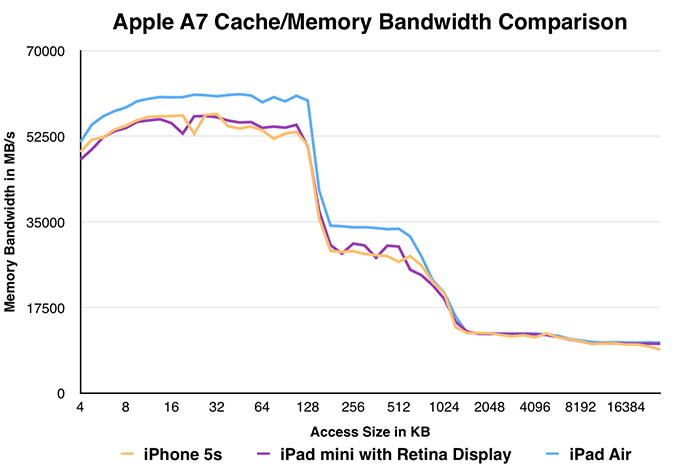








345 Comments
View All Comments
identity - Saturday, November 16, 2013 - link
What do you, know another troll bitching.Morawka - Saturday, November 16, 2013 - link
not trolling, i just find it convenient to point out anand doing all apple reviews despite having a dedicated mobile reviewer who has never done a full blown apple tablet or phone review (only previews)Friendly0Fire - Saturday, November 16, 2013 - link
I'll also say that I like Anand's work a lot but I have absolutely zero interest in Apple stuff, which makes me sad because it means I rarely get to read something from Anand.Apple product reviews are rarely a surprise anyway, so they're not even particularly informative. Iterative improvements, if anything special arose it'll have been talked about for at least six months everywhere you look at.
kyuu - Saturday, November 16, 2013 - link
Exactly. Anand does great reviews, but his time is wasted doing these Apple reviews. The only part of the review that contains any information we didn't already know from the glut of Apple coverage everywhere is the display metrics.But, it's pretty plain Anand has a love affair with Apple at this point.
ws3 - Saturday, November 16, 2013 - link
I know it must be maddening for Apple-haters when every review of an Apple product is at least generally positive, but you know what Apple says: "We don't ship junk."Puberticus - Saturday, November 16, 2013 - link
More junk! Ananda must review more junk! Only then will the masses be happy!!!Eyes rolling…
volebamus - Saturday, November 16, 2013 - link
So just curious, how many reviews in Anandtech did you actually read? I rarely actually look at the writer of these articles, but I notice that Anand in general does all of the flagship product reviews.How can you say you rarely get to read about Anand reviewing non-Apple products when he's involved with all the other manufacturers not just in Android, but Windows?
volebamus - Saturday, November 16, 2013 - link
No, I can tell you're trolling, and I created my account on Anandtech just to point it out. If you were anywhere close to objective, you'd look into the several categories of smartphones and tablets to see exactly how many reviews Anand does in mobile devices. Like I just did. Spoilers: he does MOST of the mobile reviews. Samsung, HTC, LG, Nexus, and even SURFACE out of all things. His name as reviewer is tied to all of them.But you notice a "trend" in him not letting the other reviewer do Apple tablet/phone reviews. Of course, this is completely ignoring the reviews that Anand does on ALL the other tablet/phone reviews as well.
Your bias is showing.
Morawka - Saturday, November 16, 2013 - link
The tough pill for me to swallow is the expensive storage upgrades. apple charging $100 going from 16GB to 32GB is absurd. The nand probably cost them $5 extra on the Bill of Materials, and all the other companies are only charging $50 for nand upgrades.Additionally, $130 for LTE connectivity is a bit high, but no where near the magnitude of the NAND pricing. It's sad that apple fans have to pay $630 for 32GB LTE mini. If you maxed your ipad mini with retina's specs, it would cost $830!!!!! Almost a grand for a 7 inch tablet that will be obsolete within a year. And those who buy all the bells and whistles will lose their ass when they go to sell it next year and upgrade to the new device.
Daniel Egger - Saturday, November 16, 2013 - link
Every premium vendor does that with their premium products. No matter whether we're talking BMW, Apple or HTC. The HTC One Max costs 150€ more to go from 16GB to 32GB internal storage while the HTC One is a whopping 220€ more expensive when doubling from 32GB to 64GB; and those are definitely not cheap to begin with! With that in mind $100 can be viewed as a real bargain, especially for the jump from 64GB to 128GB.